The Greek god Proteus, the son of Poseidon, had the ability to change and transform himself however he wanted, thus, he could have one shape and then change into a completely different one soon afterward.
The flowers named Proteas received their name after him, as they also have had the ability to transform themselves throughout its evolutionary path.
The best news?
There are plenty of protea types you can grow, including:
- Rose Mink Protea
- King Protea Flower
- Giant Protea Flower
- Protea Nerifolia
- Protea obtusifolia
- Protea scolymocephala
- Protea cyanroides
- Protea bishop
- Protea caffra
- Protea ‘Pink Ice”
- Protea repens
- Protea aristata
- Limestone sugarbush protea
- Protea mundii
So what do you think? Are you ready to learn about the different types of protea and protea species you can grow? Keep reading to learn more!
- Facts About the Different Types of Protea
- Cultivation of Protea Flowers
- Some Popular Types of Protea You Can Grow
- Possum Magic (Protea Magnifica x longifolia)
- Raspberry Frost (Banksia menziesii)
- Red Gym (Leucadendron)
- Rose Mink (Protea laurifolia)
- Special Pink Ice (Protea neriifolia x susannae)
- King Protea (Protea cynaroides)
- Bird’s Nest (Banksia baxteri)
- Spider (Leucospermum)
- Susara (Protea susannae x Magnifica)
- Pincushion Protea (Leucospermum cordifolium)
- Banksia Ashby
- Skyrocket (Leucospermum reflexum var. luteum)
- Banksia Media
- Limestone Sugarbush (Protea obtusifolia)
- Black Beard (Protea lepidocarpodendron)
- Vanessa (Leucospermum)
- Venus PBR (Protea rupens x aristata)
- Burgundy Sunset PBR (Leucospermum laureolum hybrid)
- Silver Tree (Leucadendron argenteum)
- The Madiba Protea
- Juliet (Protea Magnifica x pudens)
- Mint Julep (Banksia speciosa)
- The Queen Protea (Protea Magnifica)
- The Duchess Protea (Protea eximia)
- Cream Mink (Protea neriifolia)
- High Gold (Leucospermum)
- Blushing Bride (Serruria Florida)
- Niobe (Protea neriifolia x laurifolia)
- Protea Compacta
- Protea Aristata
- Lady Di (Protea compacta x Magnifica)
- Blyde Protea (Protea laetans)
- Donna (Protea compacta hybrid)
- Protea Mundii
- Protea Lanceolata
- Waratah (Telopea speciosissima)
- Frosted Fire (Protea neriifolia hybrid)
- Common Protea (Protea caffra)
- Protea Longifolia
- Thistle (Protea scolymocephala)
- Protea Roupelliae (subspecies hamiltonii)
- Protea Nitida
- Serpentine sugarbush (Protea curvata)
- Common Questions About Protea Plants
- Tips for Growing Proteas
Facts About the Different Types of Protea
Proteas (sometimes known as fynbos or sugarbushes) can now be found in many different shapes, textures, colors, and sizes.
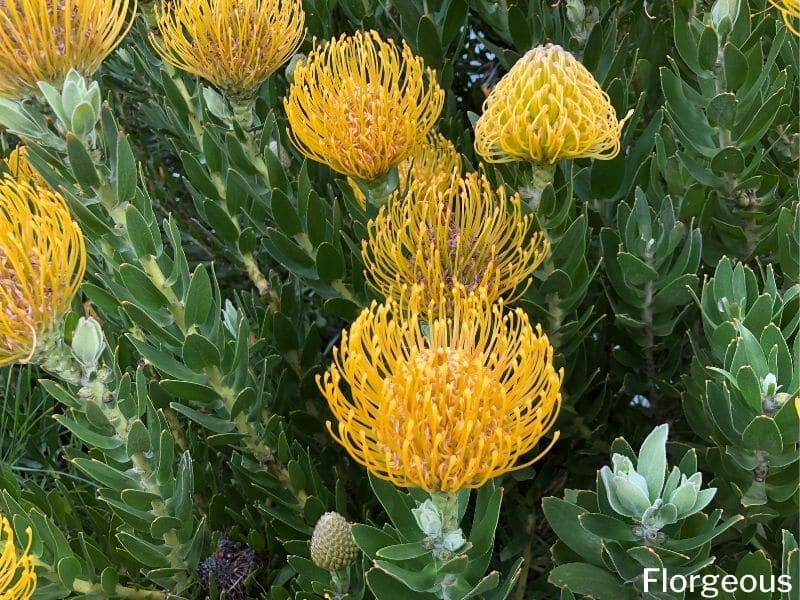
One thing is for sure about these flowers, if you are lucky enough to see one, then you will either love it or hate it immediately!
They are not like any other flower or plant you have ever seen, in fact, they are one of the most unusual, yet, beautiful flowers out in nature.
Also, did you know that proteas are really old? They come from the family Proteaceae and their genus is Protea. They are all native to South Africa (more specifically the Cape Floristic Region), Australia, and South America. And all of these countries are considered to be hotspots for flora and fauna lovers.
These South African flowers come in many different shapes and look beautifully when mass planted. Their deep green leaves are attractive on their own, but add to the fact that the beautiful blooms attract pollinators and nectar feeding birds? Forget about it!
You can grow protea plants in acidic soil, but if you don’t have acidic soil, you’ll find that this evergreen shrub still thrives. These flowering plants are adaptable and there are lots of flowers in the Protea family to choose from.
The Proteaceae family is divided into five subfamilies which hold a total of 75 genera and at least 1,350 different species (1).

These types of flowers are often pollinated by bats, birds, and even small marsupial mammals, so they are very important in many ecosystems.
They are also known for thriving in difficult and warmer climates where many other types of flowers would probably die.
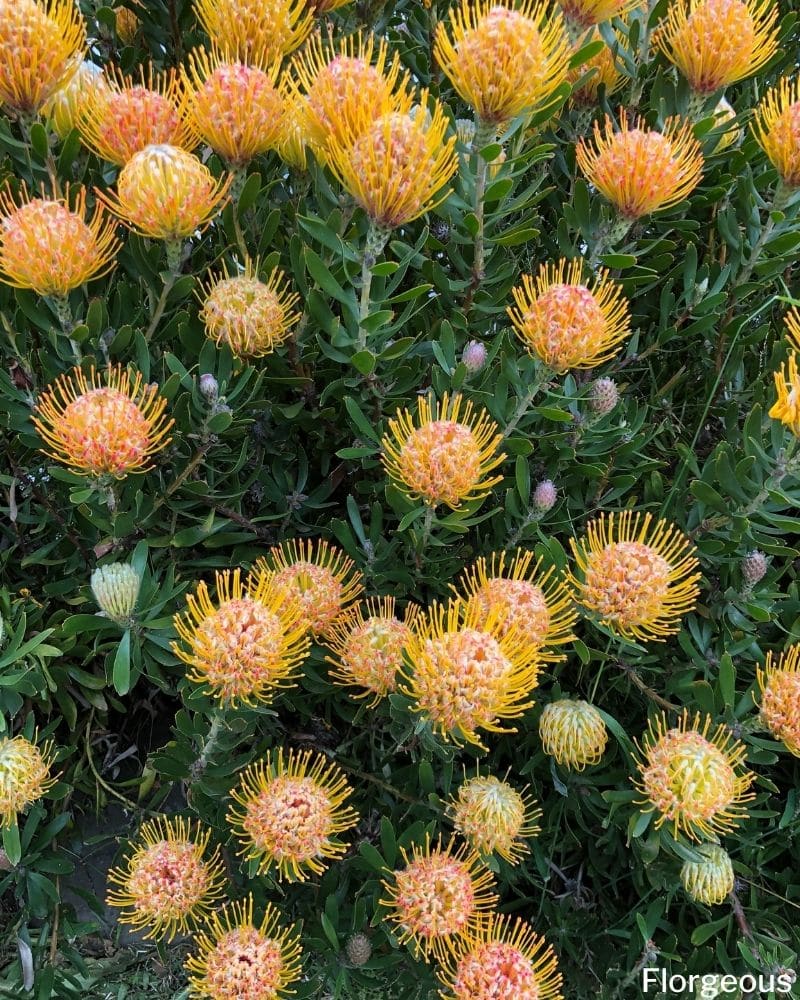
Another important characteristic is the shape of their roots, but because they are clumped into one another, they allow water to be absorbed even better.

The Proteaceae family is subdivided into two species: the Proteoideae (which are found in South Africa) and the Grevilleoideae (which are found in Australia and South America).
Proteas can either grow as shrubs or tall trees, depending on where they live. They also have a different leaf structure from other types of flowers, as they are arranged in a spiral form in the center, surrounding the stem.
These stems are very important to them as they can also absorb water, and this has resulted as an evolutionary characteristic due to the long periods of drought that these flowers have had to endure, as it became the plant’s only way to survive (2).
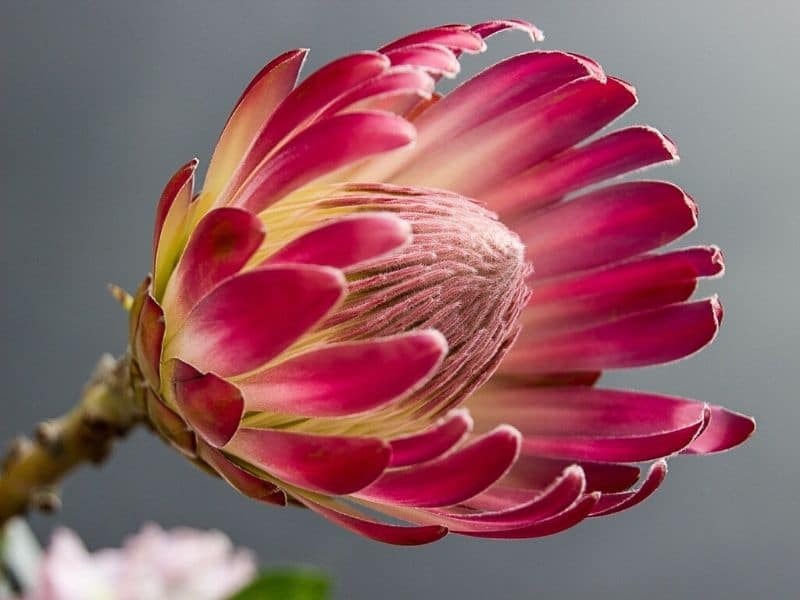
The protea flowers are tubular flowers and can be either yellow, pink, red, white, cream, and orange.
The African landscape (and the Australian one too) have often been engulfed by fire, thus whenever this occurs the proteas are able to continue its evolution and survive without much damage (3).
This condition is good, especially nowadays when fires are more frequent.
In fact, proteas have learned so much from themselves and their abilities that they can now self-insulate some of their tissues so they can resist the weather, even if it’s too hot sometimes.
Some other proteas depend on fire to grow as they need to be exposed to burning and heat before opening and releasing their seeds.
Cultivation of Protea Flowers

Because of their characteristics, proteas need to grow in an open space that is sunny for most of the day and that is also well-ventilated.
They also need acidic soil that has a lot of gravel and sand. They can either be propagated by their seeds or they can be cut off and then be reproduced separately.
In terms of their conservation needs, proteas are well adapted to naturally difficult climates and habitats, even though some of the species of this family are now at risk of extinction (4).
There are at least 360 South African species and around 120 of them are now classified as an endangered species.
Wild proteas also face another problem that is the continuous fires that have been going on non-stop for the last couple of months.

Some Popular Types of Protea You Can Grow
Possum Magic (Protea Magnifica x longifolia)
This dense bush has golden pink or creamy-yellow petals with orange tips. They have a dark brown and black center that helps attract bees and other pollinators. They require little water and are very hardy. They are ideal for small areas.
Raspberry Frost (Banksia menziesii)

This type of protea has a cone that is very eye-catching. It has a red tone to it and silver stripes with a yellow bottom ring. The heads can grow up to four inches long and three inches wide, thus they are great for decoration purposes.
Red Gym (Leucadendron)
As the name suggests, this protea species has bright red petals and a bright green stem. Its center is white and very big. They are low maintenance as they don’t need much water to thrive.
Rose Mink (Protea laurifolia)
This is one of the most beautiful protea species. It has dark-pink petals that are tilted and white tips. They have long petals that can catch everybody’s attention. Pollinators love this type of protea!
Special Pink Ice (Protea neriifolia x susannae)
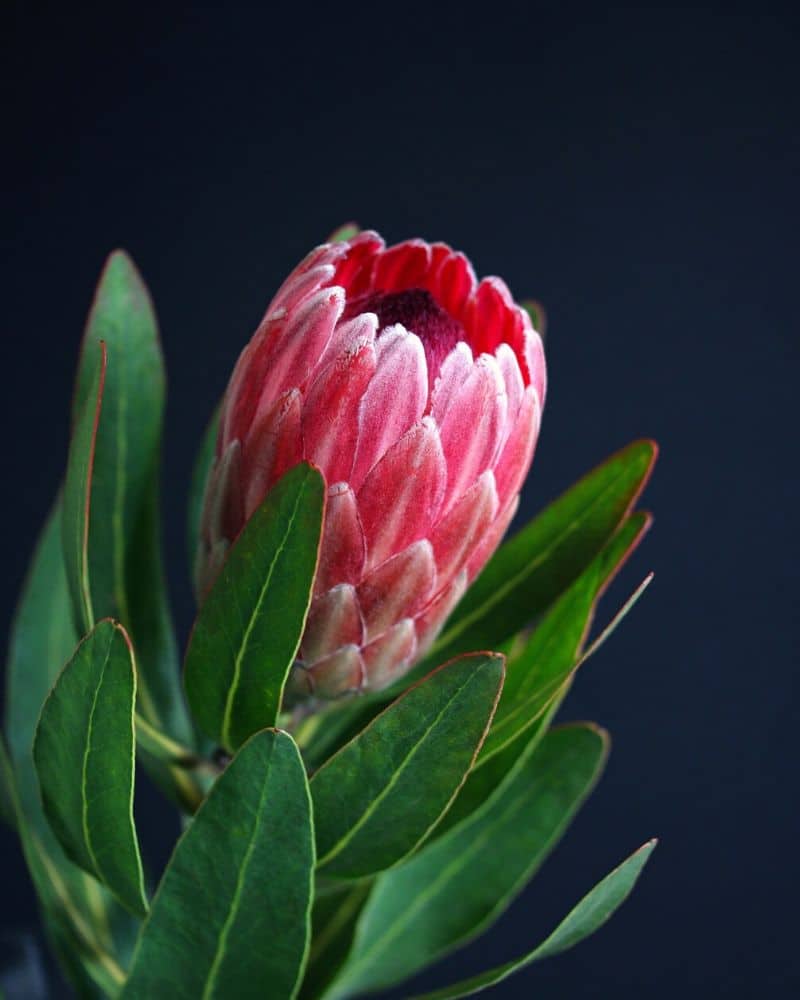
This is a hardy type of protea as it can stand really harsh climates. It has deep-pink petals and long dark-green leaves. They don’t need much water so they are considered one of the easiest types of proteas to have.
King Protea (Protea cynaroides)

One of the most and easiest to recognize proteas, they have yellow and red flowers in the center and their outer tips are pink. Because of its colors, this type of protea resembles a crown. King Protea is the national flower of South Africa (5).
There are two varieties of this flower, which are:
King White
It has white petals and green-lime spikes and a big center. They prefer being fully exposed to the sun and to have rocky soil where they can thrive best. They propagate easily and need a lot of room to expand themselves.
King Pink
It has pink petals that turn pale-pink as they mature. Its leaves are bright yellow. They are also one of the biggest proteas, so they require a lot of space.
These types of protea are some of the most beautiful you will find, especially when mass planted.
Bird’s Nest (Banksia baxteri)
Its leaves are bright green and they have a lime-green bloom that catches everybody’s attention!
Spider (Leucospermum)
It has golden-yellow spikes and hot-pink tips! They also have a big center with short orange and red spikes and magenta tips. If you ever see this protea species then you will want to have a garden filled with them!
Susara (Protea susannae x Magnifica)
A small protea, it has coral petals with cream and yellow tips. They also have another large center which is coral and pink and has a small dark circle in the middle of it to attract pollinators.
Pincushion Protea (Leucospermum cordifolium)

These types of protea have a beautiful appearance because they have long stems that go round the center. They are an evergreen shrub and can only grow up to four feet tall. Insects love them as they get the nectar from the flower’s tips.
Banksia Ashby
This type of protea has very thin bright-orange spikes that form a cone-shaped flower. These flowers are very striking and birds love them as they get to have a lot of nectar from them.
Skyrocket (Leucospermum reflexum var. luteum)
In some areas, these types of protea species are known as fireworks proteas. They have yellow flowers that resemble fire, in fact, they look as if the fire was burning down from the flowers to the leaves.
Banksia Media

It has numerous thick bright-yellow flowers that are placed on top of the small leaves and dark-green stem. They are hardy to warm climates and can stand really high temperatures.
Limestone Sugarbush (Protea obtusifolia)
This flower is native to South Africa. It has yellow flowers with pink tips that seem to go inwards. They can grow up to six inches in height.
Black Beard (Protea lepidocarpodendron)
Its petals are all black and they are on top of a cream-colored base. They are very small as their center can only stretch up to two inches wide. These plants int he protea family are incredibly compact, making them perfect for small gardens.
Vanessa (Leucospermum)

These protea species have dark-green leaves and dark-pink, white, yellow, and orange flowers. The spikes of this flower tend to curve upwards. They need a lot of space as they tend to propagate easily.
Venus PBR (Protea rupens x aristata)
This shrub has coral-pink flowers with long petals that can catch everybody’s attention. They are fairly easy to grow as the only requirements are to be fully exposed to the sun and well-drained soil.
If you’re looking for a low-maintenance, easy to care for protea species, this is the one for you!
Burgundy Sunset PBR (Leucospermum laureolum hybrid)
It has deep-burgundy petals and vibrant green leaves. They are one of the hardiest types of proteas as they bloom throughout fall and winter. They are very easy to cultivate.
Silver Tree (Leucadendron argenteum)
This type of flower is very interesting to look at because it has some silvery hairs on its leaves that reflect light, thus they seem to be shining all the time! They are very rare and, unlike many other proteas, they release a faint scent that helps insects find it.
The Madiba Protea
It’s a similar yet smaller version of the King Protea. It has red and pink flowers and bright green leaves. An interesting fact about this protea is that this flower was named after Nelson Mandela’s tribe.
Juliet (Protea Magnifica x pudens)
They have pink and red petals with some creamy-yellow lines. They also have a large center with a dark button that helps to attract birds and butterflies. They are perfect for small gardens as they don’t grow as much as other proteas.
Mint Julep (Banksia speciosa)

Its flowers are white and cream and they can grow up to five inches in height. They are small, thus look great in any vase! These protea species are great as cut flowers but also perform well as flowering plants in the garden.
Consider planting them alongside other flowering plants in different colors for a really beautiful display that’s sure to impress your neighbors and visitors!
The Queen Protea (Protea Magnifica)

All Kings have a Queen, right? This protea has a lilac-pìnk tone and they are one of the most sought after varieties of proteas. They have a rounded center and dark-green leaves. It’s very beautiful and insects love it!
The Duchess Protea (Protea eximia)
Its flowers are deep pink and purple and they have vibrant green foliage. They are very easy to grow in comparison to other proteas as they are very low maintenance.
Cream Mink (Protea neriifolia)
Its flowers are creamy-white and have dark tips. They are very beautiful. It also has long leaves and attracts many different birds and bees.
High Gold (Leucospermum)

They have a dome-shaped flower that has a very vibrant yellow color. They also have white spikes and vibrant green foliage.
Blushing Bride (Serruria Florida)
These beautiful flowers have white petals with a thin pink stripe. Some of them have a pink center, others have a white center, and some others have a pink and cream center. They prefer to be placed in shady areas as they don’t tolerate the heat.
Niobe (Protea neriifolia x laurifolia)
Its petals are lime-green and have a purple tip, which makes them truly beautiful. They have vibrant green foliage and are very easy to maintain.
Protea Compacta
They also need a lot of space as they tend to grow and spread apart easily.
Its leaves tend to curve upward and are very striking! They can either be white flowers with a white center or pink flowers with a white center.
Protea Aristata
It’s another well-known type. It has pink flower heads and a very vibrant, needle-like foliage.
Her stem knows how to retain water and redistribute it, thus this is a plant that has evolved throughout the years in order to survive harsh weather conditions.
Lady Di (Protea compacta x Magnifica)
One of the proteas’ hybrid plants, it has pink flowers that have a white fringe. They grow in early winter up to spring. They don’t require much water and are ideal for open spaces.
Blyde Protea (Protea laetans)
It has carmine flowers and bluish-green foliage. Unlike many other proteas, this type needs a lot of water in order to thrive, so they can only be found in areas where it rains a lot during the summer months.
Donna (Protea compacta hybrid)
It has creamy-white flowers and tips that are light pink and yellow. They look great as a cut flower and they can resist high temperatures.
Protea Mundii
They are also called forest sugarbush. They tend to grow really fast when the right soil conditions have been met. They have white and pale cream flowers and bright green foliage. This type of protea attracts birds and bees and it’s important to any ecosystem as it helps to regenerate the soil.
Protea Lanceolata
This type requires alkaline soil if possible. They have developed a tolerance for strong winds. However, it’s an endangered species as they have lost most of its habitat.
Waratah (Telopea speciosissima)
It’s native to Australia and it’s also the regional emblem for New South Wales. Its center is very large and it’s shaped like a pincushion. They are made of red spikes and have several layers of petals that have pointed tips.
Frosted Fire (Protea neriifolia hybrid)

Another type of hybrid, this protea is a dense shrub that can grow many flowers during the winter. It has orange and red petals and a white tilt on the tips. They have dark-green leaves and are very attractive to birds.
Common Protea (Protea caffra)
They are usually white flowers with very bright foliage. They tend to grow fast and are hardy to extreme climates.
Protea Longifolia
One of the fastest-growing proteas, they have long and dark leaves. This flower can be yellow, green, cream and white, with a light orange and pink tilt.
Thistle (Protea scolymocephala)
It has creamy and green petals. Ideal for small gardens as they don’t grow as much as other types of proteas.
Protea Roupelliae (subspecies hamiltonii)
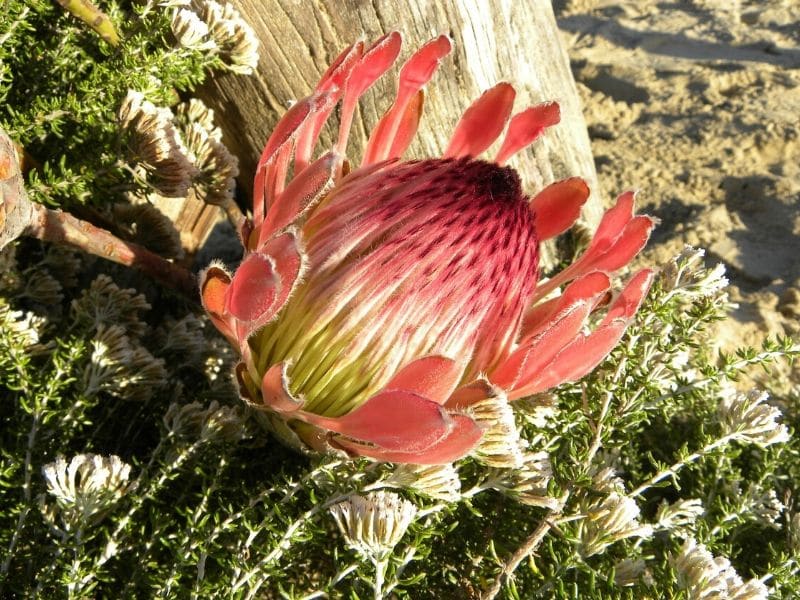
This is one of the few dwarf proteas. They have beautiful cream and pink flower heads that bloom throughout the summer.
Protea Nitida

Also called wagon tree, it’s the only type of protea that develops large trees that can be used as timber. They have yellow petals and a white center.
Serpentine sugarbush (Protea curvata)
It’s a protected plant in South Africa. They are pink (sometimes pale purple) and have white on their tips. Its center is white, however, there is some serpentine sugarbush that has a purple center.
Common Questions About Protea Plants
Where do Protea flowers grow?

Because protea flowers are most-known in South Africa and Australia, people usually think they are native to those areas and that they cannot be found anywhere else in the world.
However, this isn’t the case as protea plants are native to the Southern Hemisphere too, therefore they can also be found in some countries in South America.
Because of their evolution, they now have specific requirements that will help them thrive, thus many people (especially beginners’ gardeners) tend to avoid cultivating this flower.
Due to the climate characteristics of these countries, protea flowers are used to being exposed to the sun where the soils are well-drained and where the heat is constant.
Is the Protea flower poisonous?

Protea’s flowers, its nectar, and the seeds are very poisonous to human beings, dogs and cats.
In fact, all parts of this plant can cause irritation on the skin and pain in the mouth and tongue if they are consumed.
In addition, the bulb is very toxic to children, so be very careful.
What does Protea flower symbolize?

You’ll be amazed to discover the meaning of protea flowers. They symbolize diversity because their flowers come in different shapes and forms, but they also symbolize strength because they are able to grow in places where flowers tend to die.
Tips for Growing Proteas

Protea flowers aren’t very difficult to grow, but this isn’t an easy task either. The first thing you need to be aware of is the soil, as they need to grow in well-drained soil.
Most of the plants need to be fully exposed to the sun throughout the day. Thus the more sun they receive the better.
Proteas don’t need much water so you should water them every two to three weeks.
You should trim the flowers that are well-established, especially if you see any dead leaves or petals.
Conclusion

Proteas are one of the most beautiful and intriguing plants that nature has provided us!
They are not only interesting because of how they look but also because of the chemical composition that makes them highly toxic.
However, despite this toxicity, proteas remain a very popular flower choice in many gardens and houses all over the world, especially since they attract many pollinators that are good for the maintenance of the different ecosystems (6).
If you love protea, don’t forget to check our gardening blog for more plants and flowers.
References
Reference List:
- Marincowitz, S., Groenewald, J. Z., Wingfield, M. J., & Crous, P. W. (2008). Species of Botryosphaeriaceae occurring on Proteaceae. Persoonia, 21, 111–118. https://doi.org/10.3767/003158508X372387
- Treurnicht, Martina. (2014). Taking a closer look at Proteas. Veld & Flora. 100. 172.
- Delgado, M., Valle, S., Reyes-Díaz, M., Barra, P. J., & Zúñiga-Feest, A. (2018). Nutrient Use Efficiency of Southern South America Proteaceae Species. Are there General Patterns in the Proteaceae Family?. Frontiers in plant science, 9, 883. https://doi.org/10.3389/fpls.2018.00883
- He, T., D’Agui, H., Lim, S. et al. Evolutionary potential and adaptation of Banksia attenuata (Proteaceae) to climate and fire regime in southwestern Australia, a global biodiversity hotspot. Sci Rep 6, 26315 (2016). https://doi.org/10.1038/srep26315
- Dupee, S.A. & Goodwin, P.B.. (1992). FLOWERING AND VEGETATIVE GROWTH OF PROTEA NERIIFOLIA AND PROTEA CYNAROIDES. Acta Horticulturae. 81-98. 10.17660/ActaHortic.1992.316.14.
- Cárdenas, S., Nivelo-Villavicencio, C., Cárdenas, J., Landázuri P., O., & Tinoco, B. (2017). First record of flower visitation by a rodent in Neotropical Proteaceae, Oreocallis Grandiflora. Journal of Tropical Ecology, 33(2), 174-177. DOI:10.1017/S0266467417000025
Close
*Featured Photo by pomphotothailand.gmail.com/depositphotos







